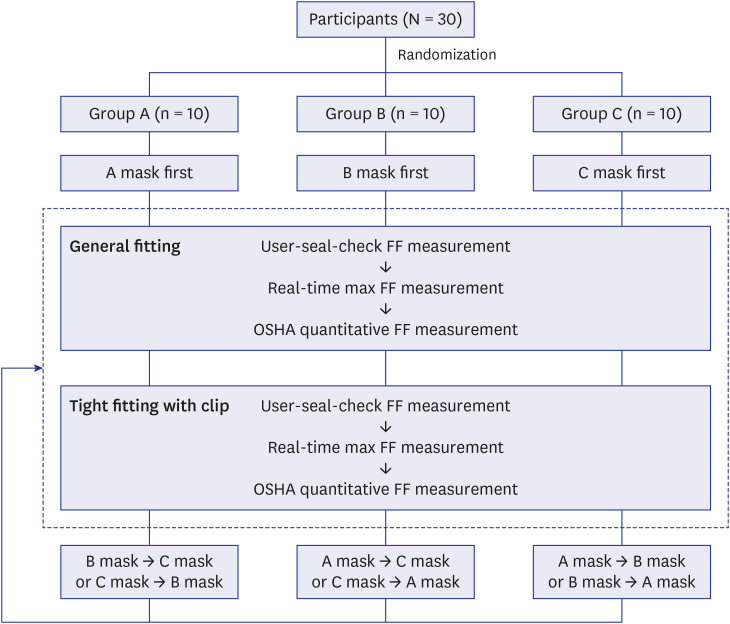J Korean Med Sci.
2021 Jul;36(28):e209. 10.3346/jkms.2021.36.e209.
Respiratory Protection Effect of Earloop-type KF94 Masks according to the Wearing Method in COVID-19 Pandemic: a Randomized, Open-label Study
- Affiliations
-
- 1Department of Emergency Medicine, Samsung Medical Center, Sungkyunkwan University School of Medicine, Seoul, Korea
- KMID: 2518527
- DOI: http://doi.org/10.3346/jkms.2021.36.e209
Abstract
- Background
Ear-loop-type Korean Filter 94 masks (KF94 masks, equivalent to the N95 and FFP2) are broadly used in health care settings in Korea for the coronavirus disease 2019 pandemic.
Methods
A prospective randomized open-label study was designed to identify differences in the fitting performance between mask wearing methods in three different types of KF94 mask with ear loops between January to March 2021. General-fitting involved wearing an earloop-type KF94 mask, and tight-fitting involved wearing a mask aided by a clip connecting the ear loops. Each of the 30 participants wore three types of masks according to a randomly assigned order in both methods and performed a total of six quantitative fit tests (QNFTs) according to the occupational safety and health administration protocol.
Results
All fit factors (FFs) measured by the QNFT were significantly higher for tight-fitting method with the clip in all KF94 masks (P < 0.001). However, the total FFs were very low, with a median (interquartile range) of 6 (3–23) and 29 (9–116) for general-fitting and tight-fitting, respectively. When wearing tightly, the horizontal 3-fold type mask with adjustable ear-loop length had the highest FF, with a median of 125, and the QNFT pass rate (FF ≥ 100) increased significantly from 4 (13%) to 18 (60%).
Conclusion
Even with sufficient filter efficiency, ear-loop-type-KF94 masks do not provide adequate protection. However, in relatively low-risk environments, wearing a face-seal adjustable KF94 mask and tight wearing with a clip can improve respiratory protection for healthcare workers.
Keyword
Figure
Reference
-
1. World Health Organization. Infection prevention and control during health care when coronavirus disease (COVID-19) is suspected or confirmed: interim guidance (29 June 2020). Updated 2020. Accessed March 7, 2021. https://apps.who.int/iris/handle/10665/331495.2. Korea Center for Disease Control and Prevention (KCDC). Infection prevention and control for COVID-19 in healthcare facilities (March 10, 2020). Updated 2020. Accessed March 7, 2021. http://ncov.mohw.go.kr/shBoardView.do?brdId=2&brdGubun=24&ncvContSeq=1277.3. Coia JE, Ritchie L, Adisesh A, Makison Booth C, Bradley C, Bunyan D, et al. Guidance on the use of respiratory and facial protection equipment. J Hosp Infect. 2013; 85(3):170–182. PMID: 24051190.
Article4. Han DH. Usage of filtering-facepiece masks for healthcare workers and importance of fit testing. J Korean Soc Occup Environ Hyg. 2015; 25(3):245–253.
Article5. Hwang SY, Yoon H, Yoon A, Kim T, Lee G, Jung KY, et al. N95 filtering facepiece respirators do not reliably afford respiratory protection during chest compression: a simulation study. Am J Emerg Med. 2020; 38(1):12–17. PMID: 30955924.
Article6. Karuppasamy K, Obuchowski N. Comparison of fit for sealed and loose-fitting surgical masks and N95 filtering facepiece respirators. Ann Work Expo Health. 2021; 65(4):463–474. PMID: 33458738.
Article7. United States Department of Labor. Occupational safety and health act. 29CFR 1910.134. Respiratory protection. Updated 2011. Accessed March 07, 2021. https://www.osha.gov/laws-regs/regulations/standardnumber/1910/1910.134.8. Bergman M, Zhuang Z, Brochu E, Palmiero A. Fit assessment of N95 filtering-facepiece respirators in the U.S. Centers for Disease Control and Prevention Strategic National Stockpile. J Int Soc Respir Prot. 2015; 32(2):50–64. PMID: 26877587.9. Centers for Disease Control and Prevention (CDC). The National Personal Protective Technology Laboratory (NPPTL). NPPTL respirator assessments to support the COVID19 response. Updated 2021. Accessed March 7, 2021. https://www.cdc.gov/niosh/npptl/respirators/testing/default.html.10. World Health Organization. How to perform a particulate respirator seal check. Updated 2008. Accessed March 7, 2021. https://www.who.int/csr/resources/publications/respiratorsealcheck/en/.11. Occupational Safety and Health Administration. Supplement A to § 1910.134: Fit Testing Procedures (Mandatory). Updated 2004. Accessed March 7, 2021. https://www.osha.gov/laws-regs/regulations/standardnumber/1910/1910.134AppA/.12. Yu Y, Jiang L, Zhuang Z, Liu Y, Wang X, Liu J, et al. Fitting characteristics of N95 filtering-facepiece respirators used widely in China. PLoS One. 2014; 9(1):e85299. PMID: 24465528.
Article13. Huh YJ, Jeong HM, Lim J, Park HY, Kim MY, Oh HS, et al. Fit characteristics of N95 filtering facepiece respirators and the accuracy of the user seal check among Koreans. Infect Control Hosp Epidemiol. 2018; 39(1):104–107. PMID: 29345612.
Article14. Noti JD, Lindsley WG, Blachere FM, Cao G, Kashon ML, Thewlis RE, et al. Detection of infectious influenza virus in cough aerosols generated in a simulated patient examination room. Clin Infect Dis. 2012; 54(11):1569–1577. PMID: 22460981.
Article15. Han DH, Park Y, Woo JJ. Effect of the tight fitting net on fit performance in single-use filtering facepieces for Koreans. Ind Health. 2018; 56(1):78–84. PMID: 28855449.
Article16. Clapp PW, Sickbert-Bennett EE, Samet JM, et al. Evaluation of cloth masks and modified procedure masks as personal protective equipment for the public during the COVID-19 pandemic. JAMA Intern Med. 2021; 181(4):463–469. PMID: 33300948.
Article17. Rebmann T, Carrico R, Wang J. Physiologic and other effects and compliance with long-term respirator use among medical intensive care unit nurses. Am J Infect Control. 2013; 41(12):1218–1223. PMID: 23768438.
Article18. Centers for Disease Control and Prevention. Facial hairstyles and filtering facepiece respirators. Updated 2017. Accessed March 7, 2021. https://www.cdc.gov/niosh/npptl/pdfs/facialhairwmask11282017-508.pdf.
- Full Text Links
- Actions
-
Cited
- CITED
-
- Close
- Share
- Similar articles
-
- Fit Test for N95 Filtering Facepiece Respirators and KF94 Masks for Healthcare Workers: a Prospective Single-center Simulation Study
- Systematic Literature Review on Coronavirus Infectious Disease-19 and Dental Masks
- Effect of Mask Mandates on the Intraocular Pressure Measured via Goldmann Applanation Tonometry
- Importance of Wearing Facial Masks to Prevent Nosocomial Transmissions of COVID-19
- The association between tobacco or nicotine product use behaviors and non-compliance with mask-wearing during the COVID-19 pandemic: a cross-sectional study in Korea




